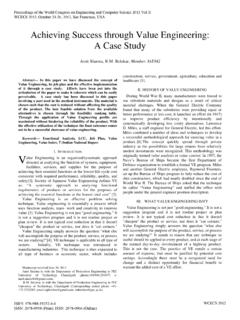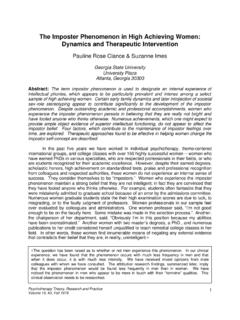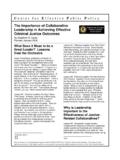Transcription of #123forEquity: A Toolkit for Achieving Success and …
1 #123forEquity:A Toolkit for Achieving Success and Sharing Your Story Dear Colleague: To meet the changing needs of our communities, hospitals and health systems are working hard to make sure that every individual receives the highest quality of care. To achieve that goal as our nation becomes increasingly diverse, we must redouble our efforts to identify and eliminate disparities in care. That s why the AHA last year launched the #123forEquity Pledge to Eliminate Health Care Disparities. The pledge campaign urges hospital and health system leaders to begin taking action in the next 12 months on specific areas that can improve health equity; provide updates on their organization s progress; and share their Success in promoting diversity and health equity with the public. To support your efforts, we have developed #123forEquity: A Toolkit for Achieving Success and Sharing Your Story. The Toolkit contains resources that can assist all hospitals whether your organization is just beginning this journey or is already deeply ingrained in this work.
2 It includes: A checklist of resources to help you achieve the #123forEquity goals FAQs on the #123forEquity campaign A sample slide presentation for use with your board of trustees and community Content for social and digital media An Op-Ed/newsletter article you can customize to use with your local media Case examples from the field and best practices for Success Please share this Toolkit with your leadership and communication teams. Additional resources related to the #123forEquity campaign are available on If your hospital or health system has already signed the #123forEquity pledge, thank you for your efforts and leadership on this vital issue. If your organization has not signed the pledge, please consider signing the pledge today. It s not only the right thing to do .. it s the smart thing to do. Sincerely, Richard J. Pollack M. Tom s Le n President and Chief Executive Officer President and CEO American Hospital Association Institute for Diversity in Health Management Focus One: Increase the collection and use of race, ethnicity and language preference (REAL) data Ensure that REAL data collection is systematic and reliable Health Research & Educational Trust Disparities ToolkitImproving Health Equity Through Data Collection AND Use: A Guide for Hospital Leaders Use the data to stratify quality metricsA Framework for Stratifying Race, Ethnicity and Language Data Identify disparities or confirm none existNEW: CMS Mapping Medicare Disparities ToolNEW: CMS Guide to Preventing Readmissions Among Racially and Ethnically Diverse Medicare BeneficiariesReducing Health Care Disparities: Collection and Use of Race, Ethnicity and Language DataFocus Two.
3 Increase cultural competency training Make cultural competency training a part of the orientation of all employees and ensure all clinical staff receive the trainingBuilding a Culturally Competent Organization: The Quest for Equity in Health Care Include training on the following competency areas: language services; family / community interactions; religious beliefs affecting health care; languages spoken by patients; diverse health beliefs held by patient populations Becoming a Culturally Competent Health Care Organization Continually assess training and impact to gauge Success and identify opportunities for improvementEliminating Health Care Disparities: Implementing the National Call to Action Using Lessons LearnedFocus Three: Increase diversity in leadership and governance Communicate across the organization the business imperative of having a leadership team and board reflective the communities servedRising Above the Noise.
4 Making the Case for Equity in Care Develop chief diversity officer roles to elevate diversity as a strategic priorityThe Role of the Chief Diversity Officer in Academic Health Centers Think long term to ensure a deep pool of qualified candidatesBest Practices for Building Leadership Diversity ProgramsChecklist of Resources to Help You Achieve the Goals of the #123forEquity PledgeBuilding on the work of the National Call to Action to Eliminate Health Care Disparities, the #123forEquity pledge campaign focuses on three areas that are critical to identifying and addressing disparities in care. Those include increasing the collection and use of race, ethnicity and language preference data; increasing cultural competency training; and increasing diversity in governance and leadership. Below is a checklist with links to resources that can assist your hospital or health system as you begin or continue your efforts to ensure equitable care is being provided to all patients in your community.
5 Additional resources can be found on 2015 Equity of Care:A Toolkit for Eliminating Health Care Disparities 1A Framework for Stratifying Race, Ethnicity and Language Data Signature Leadership SeriesA Framework for Stratifying Race, Ethnicity and Language Data October 2014 Signature Leadership SeriesReducing Health Care Disparities: Collection and Use of Race, Ethnicity and Language DataAugust 20131 Best Practices for Building Leadership Diversity ProgramsBest Practices for Building Leadership Diversity ProgramsBuilding a diverse leadership team requires commitment, time and a variety of best practices. Diversity practices that best fit a health care organization will be highly customized to the organization s governance, culture and community needs. Through self-examination, hospital and health care system leaders can identify blind spots and match best practices to address those areas. Each best practice can be molded to fit different career levels within the organization, though some best practices may be more appropriate for one or more levels.
6 Best practices being used by hospitals and health care systems include mentoring programs, partnerships with educational groups, and internal diversity committees, described with examples in the table Best Practices for Building Leadership Diversity Programs. In addition to commitment and time, allocating funds such as tuition reimbursement or seed money is important to support formal mentoring programs and Practices for Building Leadership Diversity ProgramsBest PracticesEntry LevelMid-career LevelC-suite LevelBoard LevelExternal ResourcesLocal and national diversity-related organizations offer resources that range from exposure to new ideas through shared best practices, conferences and case studies, to fellowships and formal mentoring StudyThe Institute for Diversity in Health Management s Summer Enrichment Program matches and places minority health administration graduate students with health care organizations for a 10-week paid internship.
7 More than 700 students have successfully completed the The Institute for Diversity and the Center for Healthcare Governance also host the Hospital Trustee Professionalism program, a series of American Hospital Association-sponsored educational programs designed to prepare participants for service as hospital board members. The institute s Minority Trustee Candidate Registry compiles profiles and resumes from everyone who has attended one of the Hospital Trustee Professionalism events. Attendees may maintain their profile on the registry, using connections with the AHA, to be available and eligible for placement on a hospital trustee In addition, the institute s Career Center offers an online searchable database, which links health care employers and diverse job Leadership SeriesBuilding a Culturally Competent Organization: The Quest for Equity in Health CareJune 2011 Signature Leadership SeriesBecoming a Culturally Competent Health Care Organization June 2013 Eliminating Health Care Disparities: Implementing the National Call to Action Using Lessons Learned February 2012 Rising Above the Noise: Making the Case for Equity in Care Frequently Asked Questions on the #123forEquity Pledge to Eliminate Health Care Disparities Thank you for your interest in the #123forEquity campaign.
8 We have put together a list of Frequently Asked Questions (FAQs) to assist you with questions that may arise as you discuss the campaign with your staff, board, community members or others. For additional resources, please visit If you have questions, please contact us at (312) 422-2820 or Question: What is the #123forEquity pledge campaign, and why is it important? Answer: The American Hospital Association (AHA) in 2015 launched the #123forEquity Pledge to Eliminate Health Care Disparities. Building on the work that began 2011 by the partners of National Call to Action to Eliminate Health Care Disparities, the #123forEquity campaign urges hospital and health system leaders to pledge to take action on specific areas that can improve health equity; provide updates on their organization s progress; and share their Success in promoting diversity and health equity with the public. Question: Who are the National Call to Action Partners?
9 Answer: The National Call to Action was established in 2011 by the AHA, American College of Healthcare Executives, America s Essential Hospitals, Association of American Medical Colleges and Catholic Health Association of the United States. Question: Is there an AHA video about the #123forEquity Pledge? Answer: Yes, there is a short video from AHA leadership explaining the importance of the pledge and why hospitals should participate. Question: What is the timeframe to do this work? Answer: The timeframe for this work is 12 months from when pledge is signed; however, it can be modified based on the situation of each hospital or health system. The AHA suggests a timeline for each of the pledge s action steps. More details are available here. Question: I don t have a lot of racial and ethnic diversity in my community, so what does that mean for the pledge? Answer: We still strongly encourage you to take the pledge, as diversity can come in many forms.
10 You could start with race and ethnicity when examining your data. However, every community is different so you also can stratify data by language preference or other sociodemographic variables (such as income, disability status, veteran status, sexual orientation and gender, or other) that are important to your community's health. In addition to addressing disparities for people of color, you may identify other groups such as veterans; people with psychiatric disabilities; people living in poverty; the gay, lesbian and transgender population; and others who may be experiencing disparities in care and health. Question: This work seems like it will take resources and time. Can we afford this at a time when both of these are at a premium? Answer: In addition to being the right thing to do, eliminating health care disparities is vital as our health care system moves from a volume to a value-based payment structure. As payment becomes more dependent on outcomes, it is not financially viable to ignore persistent poor health outcomes in certain patient populations.








